

Posted by Wayne Parham [ 75.50.23.125 ] on July 08, 2008 at 18:52:13:
One of the main reasons I have always used asymmetrical horns is to match directivity in the vertical plane as well as in the horizontal plane. I have always found the matched-directivity two-way configuration to sound very smooth because it generates a uniform reverberent field. But it isn't enough to match the horn's horizontal pattern to the pattern of the midwoofer at the frequency where it collapses; It is also important to match the horn's vertical pattern to the vertical null angle caused by driver position on the baffle.
When drivers are stacked vertically on a baffle, nulls form above and below the speaker. If these nulls are placed just outside the horn's pattern, they serve to punctuate pattern control in the crossover region.
When you crossover a direct radiator to a 90° CD horn, assuming they are in phase on the forward axis, summing is constructive on-axis as well as off-axis in the horizontal plane even at large angles. So the pattern narrows smoothly from being nearly omnidirectional at low frequencies down to approximately 90° at crossover, where it remains because of the horn.
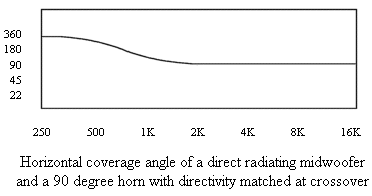
In the vertical plane, nulls form above and below the speaker at an angle set by the distance between drivers and the frequency range of the overlap in the crossover region. This is usually somewhere between 40°-60°. At 20°-30° above the forward axis and at 20°-30° below the forward axis, nulls develop. These limit vertical coverage to 40°-60°, no matter what the horn's directivity is at that frequency.
If the 90° horn is axisymmetric, then the pattern widens back up again above the crossover frequency. So the directivity of the horn is not matched to the null angle in the vertical plane, and there is some ripple through that region as a result.
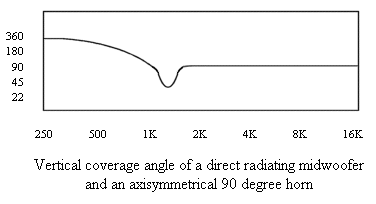
A horn with narrow vertical pattern is useful for matching directivity with the angle of the nulls in the vertical plane. If a horn is used that has 40°-50° vertical pattern, then the pattern does not widen above the crossover region. In the crossover region, the pattern is set by the off-axis nulls, and above the crossover region, it is set by the horn.
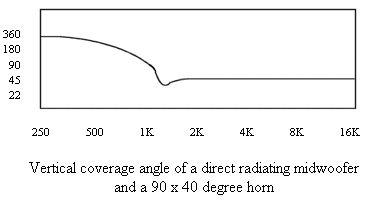
Sometimes, a horn is used that is not large enough to provide pattern control at the lowest frequencies. In this case, the pattern widens up briefly above the null frequency, and then settles back down as the horn gains pattern control. But even in that case, I think having an asymmetrical horn provides more uniform spectral balance overall.
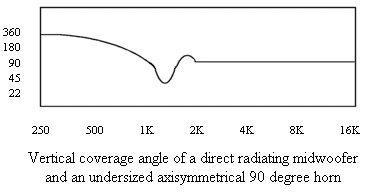 | 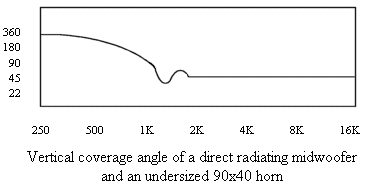 |
[ PiSpeakers Forum ] [ Help ]